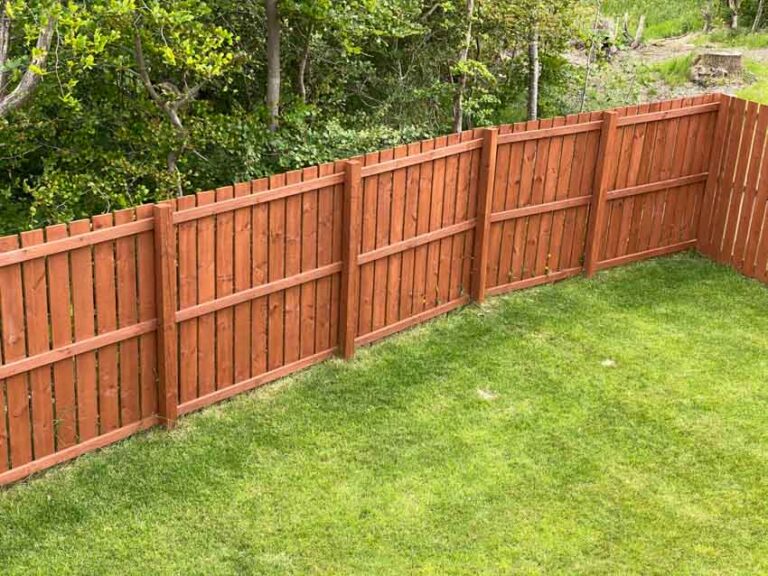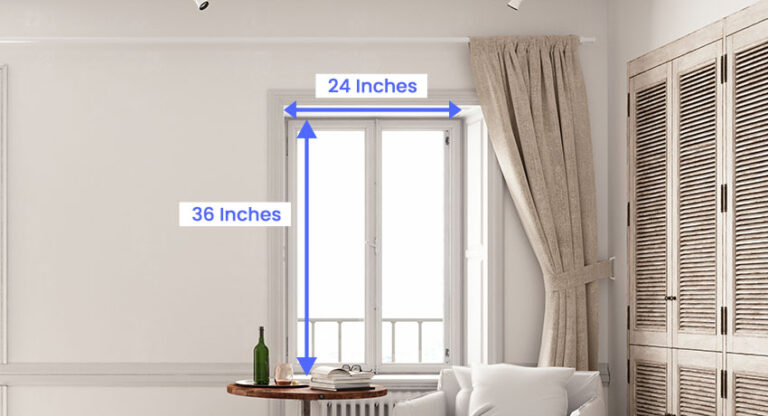Wheelbarrow Dimensions (Standard Tray, Handle & Tire Sizes)
Here’s our wheelbarrow dimensions guide including standard wheelbarrow sizes, wheelbarrow tray, handle and tire dimensions and different capacities of wheelbarrow.
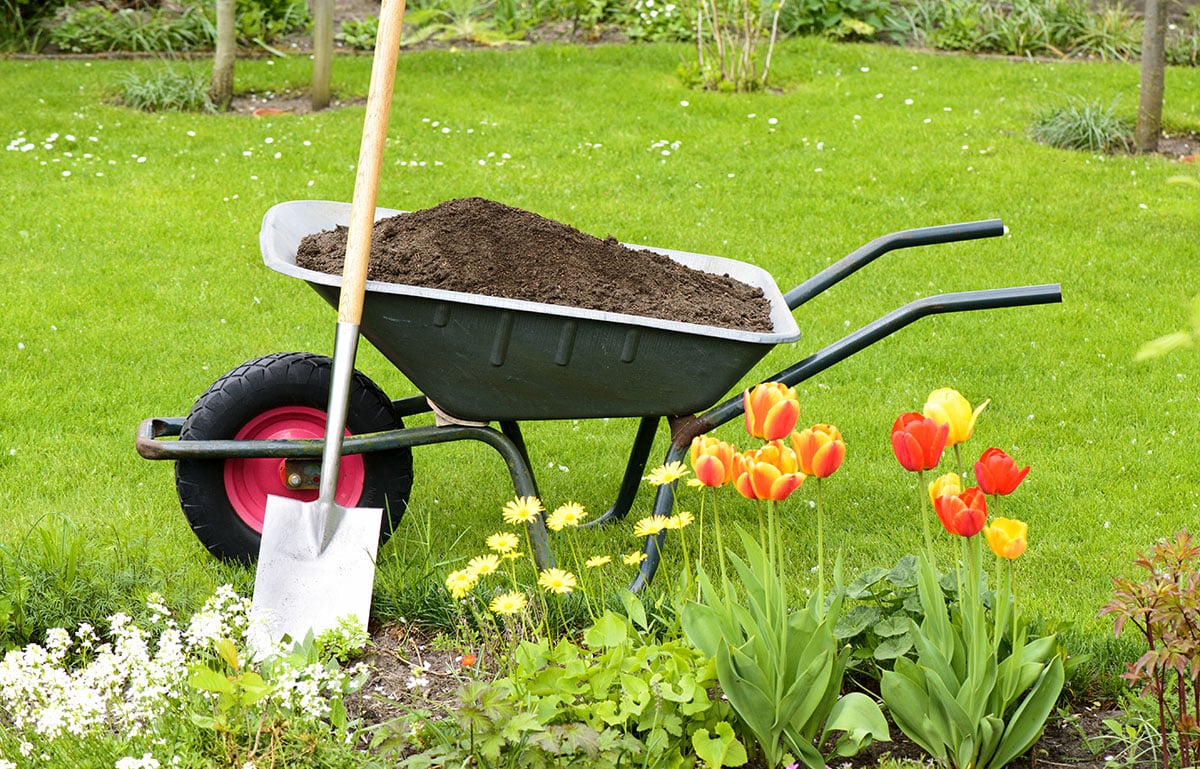
Wheelbarrows are some of the simplest tools any homeowner can have, especially when performing home improvement projects (i.e., landscaping, carpentry, masonry, gardening) and other activities requiring moving resources from one point to another.
Surprisingly, this tool still sports many of its third-century design. It has an oversized bucket or “tray” to accommodate soil, sand, gravel, wood, trash, large objects, and other items too tedious and hefty to carry by hand.
There is a wheel up front to facilitate easier transport, reducing the stress and strain of the job. Handles are present to give workers leverage, improving comfort and increasing work efficiency.
Twenty-first-century wheelbarrows only vary from their 3rd-century counterparts in materials and designs. Moreover, the sizes are now standardized, enabling homeowners and contractors to choose the right wheelbarrow for their projects, activities, and needs.
Hence, it is worth checking wheelbarrow dimensions to help individuals, families, and companies pick the right tool for any job.
Standard Wheelbarrow Sizes
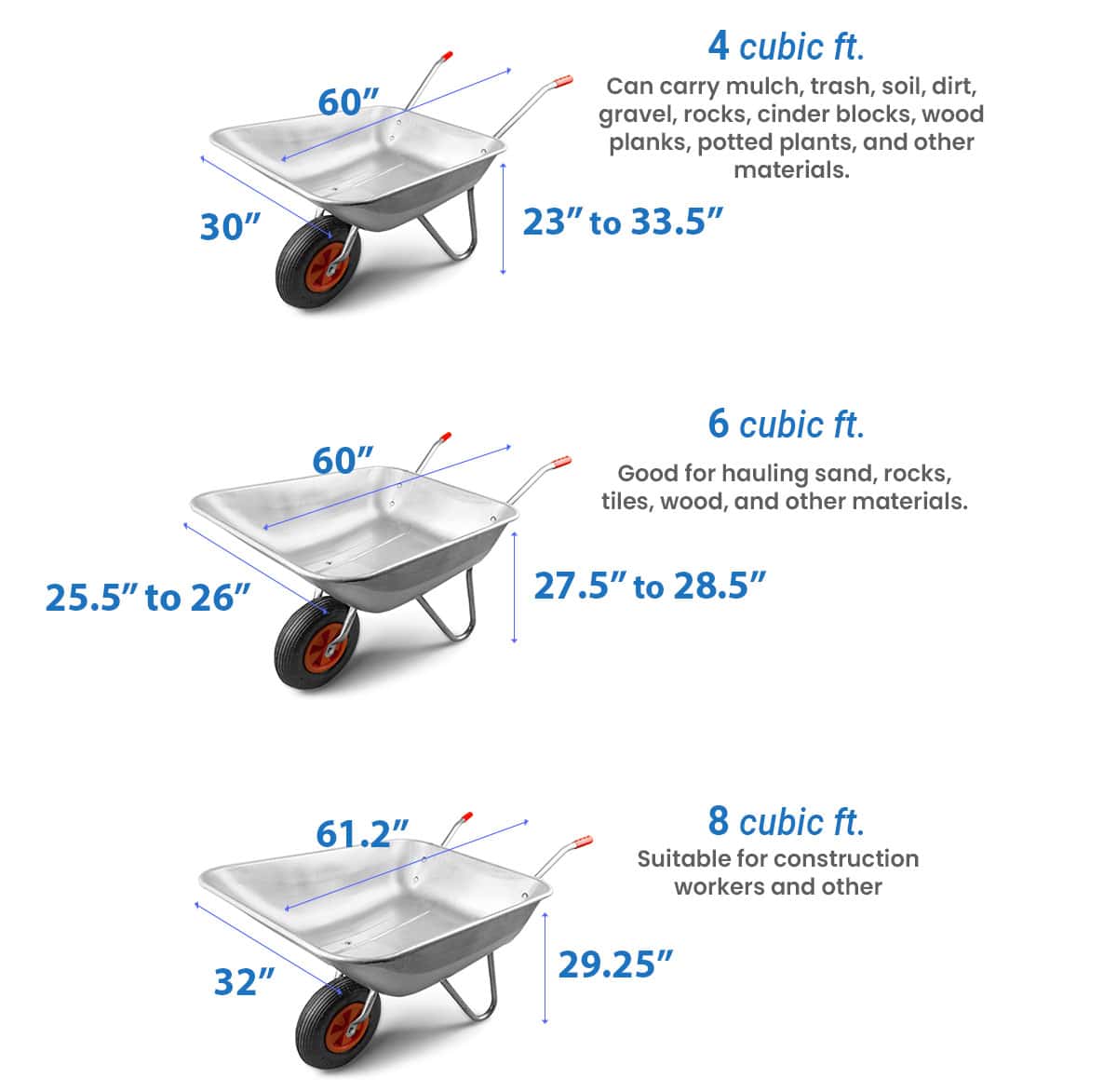
The Old English lent the word “barew” to the lexicon in describing a wheelbarrow’s purpose. It is a tool or device allowing people to carry loads – large or small, heavy or not. It is worth noting that some earlier wheelbarrow versions had sails, enabling operators to harness wind power in moving the load.
However, the front-mounted, single-wheeled cart with two handles at the rear and a pair of stands in the middle persisted through the centuries. Fast-forward to the 21st century, and the world still uses the same design, albeit with different capacities requiring varying dimensions.
Hence, contractors, procurement officers, DIYers, and homeowners can pick varying wheelbarrow dimensions according to their needs.
• 4 Cu. Ft. Wheelbarrow Dimensions
Most homeowners, DIY landscapers, and gardeners have a 4-cubic-foot (cu. ft.) wheelbarrow to transport anything around the house, backyard, and similar locations. These tools can carry mulch, trash, soil, dirt, gravel, rocks, cinder blocks, wood planks, potted plants, and other materials.
A 4 cu. ft. wheelbarrow (about 113.3 liters for people more familiar with the Metric System of measurement) measures 60 inches or 1.5 meters from the wheel’s leading edge to the handle’s rearmost tip. It is somewhat lengthy for a moving tool. Homeowners might want to consider space requirements to ensure the wheelbarrow fits when stored.
Setting the 4 cu. ft. wheelbarrow on solid and even ground will give this tool a height of about 23 to 33.5 inches or 58.4 to 85 centimeters from the surface to the wheelbarrow’s uppermost edge (i.e., the tray). It should be short enough to wheel under a shed or any structure with sufficient vertical clearance.
If one looks at the wheelbarrow from the front or the rear, its cross-section will span about 27.5 to 28.5 inches or 70 to 72.4 centimeters. Homeowners relatively new to the wheelbarrow might consider the standard width when pushing the tool between posts. The minimum clearance should be 30 inches or about three-quarters of a meter to pass through unimpeded.
It is worth noting that wheelbarrow manufacturers might deviate from these standard dimensions. However, the variances are irrelevant, provided the wheelbarrow’s tray is 4 cubic feet.
• 6 Cu. Ft. Wheelbarrow Dimensions
This wheelbarrow size is a landscaper’s best friend in hauling sand, rocks, tiles, wood, and other materials to enhance a property’s curb appeal. Contractors also choose a 6 cu. ft. (about 170 liters) wheelbarrow for light construction projects, allowing them to finish their contracts in record time.
Despite its larger capacity than a 4 cu. ft. wheelbarrow, a 6 cu. ft. version can have an identical wheel-to-handle dimension (60 inches or 1.5 meters). It is short enough to fit in a small garage or workshop shed when individuals prop the wheelbarrow on its front.
Its width might vary somewhat, although the standard is 25.5 to 26 inches or 65 to 66 centimeters. This measurement is slightly narrower than the 4 cu. ft. model, but it compensates for its tub or tray capacity.
The height is fairly similar at 23 to 33.5 inches or 58.4 to 85 centimeters. However, some manufacturers might design a taller or shorter version to accommodate specific needs. The important thing to remember is the wheelbarrow’s capacity.
• 8 Cu. Ft. Wheelbarrow Dimensions
These construction and landscaping tools are heavyweight. The average 8 cu. ft. wheelbarrow (226.5 liters) can tip the scale at 54 pounds, with some wheelbarrow versions being heftier or lighter.
Ordinary homeowners and people with diminished arm strength might have problems lifting and pushing an 8 cu. ft. wheelbarrow around the house, making this tool more suitable for construction workers and other muscled laborers.
Manufacturers of 8 cu. ft. wheelbarrow often lengthen the tool to improve its leverage, allowing workers to lift and move the simple machine from one location to another. Hence, the standard 8 cu. ft. wheelbarrow can span its wheel to handle’s tip in 61.2 inches or 1.55 meters.
An 8 cu. ft. wheelbarrow is also broader than a 6 cu. ft. version at 32 inches or 81.3 centimeters. Hence, the 30-inch minimum space for a 4 cu. ft. wheelbarrow to pass through is insufficient for this tool. It needs at least 34 inches or 86.4 centimeters of passageway.
Despite the increased length and width, an 8 cu. ft. wheelbarrow can be as tall as any other at 23 to 33.5 inches or 58.4 to 85 centimeters. Most have a height of 29.25 inches or 74.3 centimeters.
Wheelbarrow Tray Dimensions
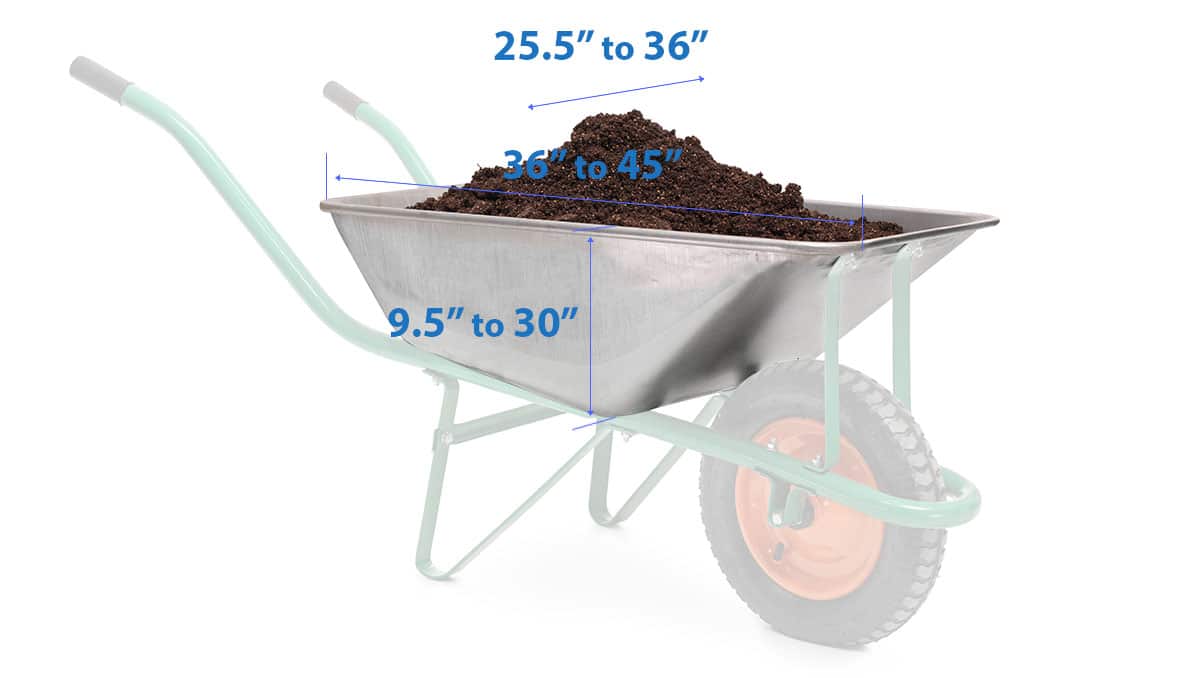
The wheelbarrow’s tray or tub is its heart, doing the carrying, and allowing people to transport virtually anything without complicated machinery. The tray should be as wide as the wheelbarrow’s standard breadth corresponding to its capacity.
However, like everything else, manufacturers can tweak their designs to produce a more efficient wheelbarrow tub.
A wheelbarrow’s tub can be as short as 36 inches (91 centimeters) or as long as 45 inches (1.14 meters), although variations exist. The tray’s deepest section can span the side at 9.5 to 40 inches (24 to 102 centimeters). Its cross-section varies from 25.5 to 36 inches (65 to 91.4 centimeters).
Besides hauling dirt, leaves, rocks, and debris, a longer tub is better for those who want to move garden tools like a shovel, rake, hoe, or other tools without them falling out as you move around.
The tray is typically made from steel or Polyethylene. A steel tray is heavier and can take more wear and tear, and comes at a higher price than a poly tray which is lighter and has more maneuverability than steel.
Wheelbarrow Handle Dimensions
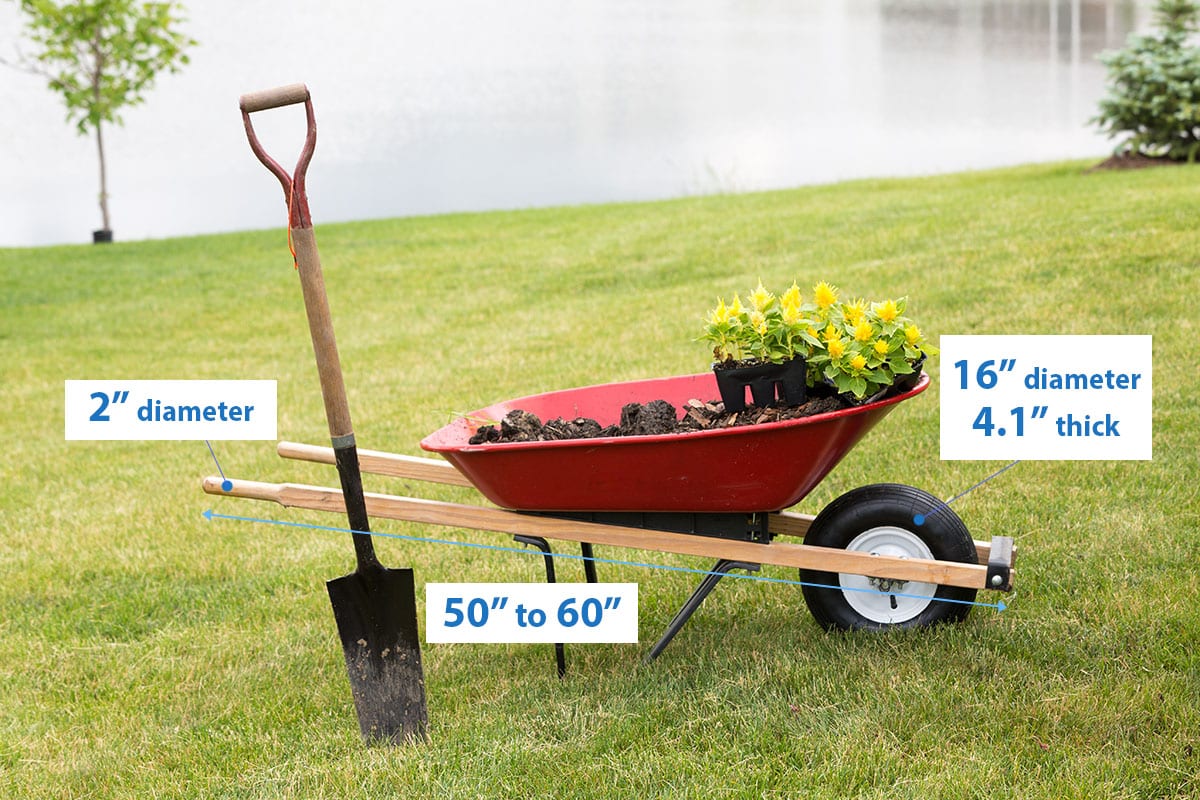
A wheelbarrow’s handle must be long enough to provide leverage when lifting a load. Too short, and workers will strain in pushing the wheelbarrow. Too long, and construction specialists and DIY landscapers will have difficulty raising the wheelbarrow off the ground.
Most wheelbarrows feature a 50-inch to 60-inch (1.27 to 1.52-centimeter) long wooden or metal handle. Equally important is the handle’s diameter. Too wide, and people with dwarfish hands will strain to lift the wheelbarrow. Too thin, and workers will have insufficient grip. Hence, the wheelbarrow handle diameter sweet spot is 2 inches or 5 centimeters.
Wheelbarrow Tire Dimensions
Most wheelbarrows have a single flat-free pneumatic tire mated at the front. Some might feature proprietary tire technologies to improve their wheelbarrows’ efficiency. Others have foam, wood, or plastic wheels. Whatever tire material the wheelbarrow has, one dimension is crucial – width (or thickness) and diameter.
Wheelbarrows must be 40.6 centimeters or 16 inches across and 10.4 centimeters or 4.1 inches thick (the distance between the tire’s opposing faces). It is worth noting that some wheelbarrow measurements might deviate a little from this standard.
Some products feature a dual wheel design that provides more stability at the expense of maneuverability. A double wheel product will help prevent the unit from tipping and be safer to operate. However, most contractors prefer a heavy steel wheelbarrow with hardwood handles to maneuver in and out of tight spaces.
When it comes to the replacement of parts, many brands have tire and hardware kits that enable you to swap out damaged pieces when needed.
Wheelbarrow Capacity
Although most wheelbarrows have 4-, 6-, and 8- cubic feet capacities, other variants are available. For example, a 7 cu. ft. wheelbarrow might be ideal for contractors who want something between a 6- and 8- cu. ft. wheelbarrow. There is also a 10 cu. ft. version for industrial applications and heavy construction work.
Interestingly, the world’s most-oversized wheelbarrow is a Boke, Germany creation. This behemoth spans 11.28 meters or 37 feet long from the handle’s tip to the wheel’s leading edge. The single wheel up front has a 2.81-meter or 110.6-inch diameter.
Visit our wheelbarrow planter ideas for more related content.


